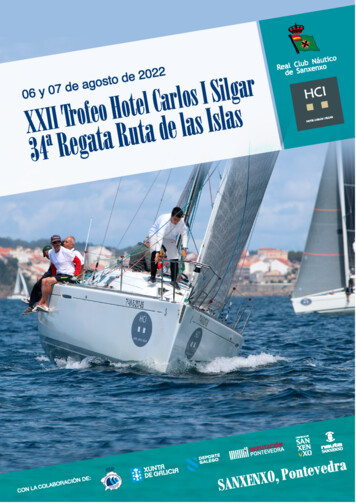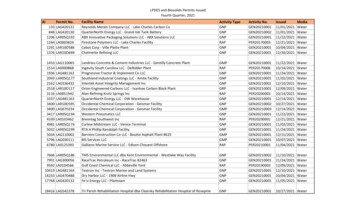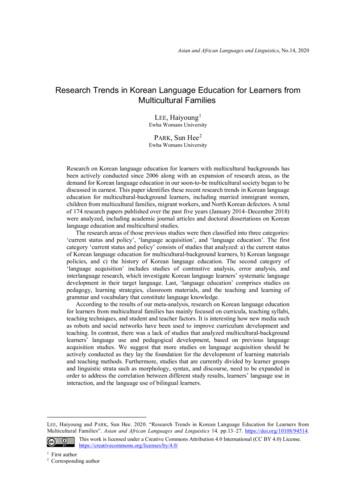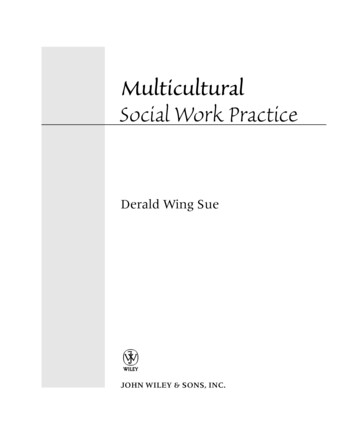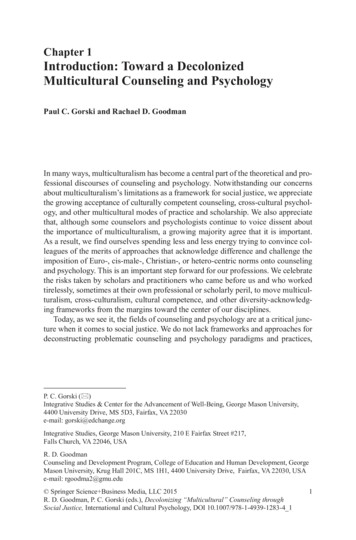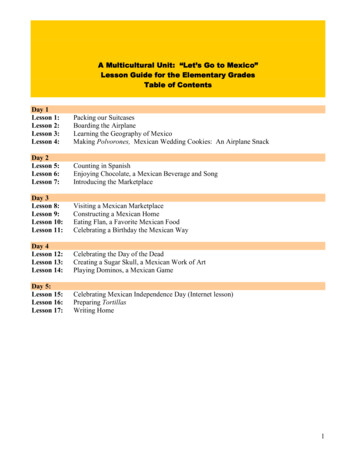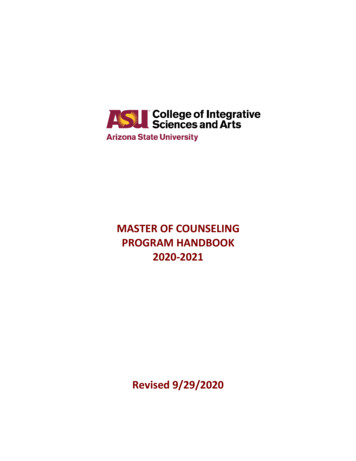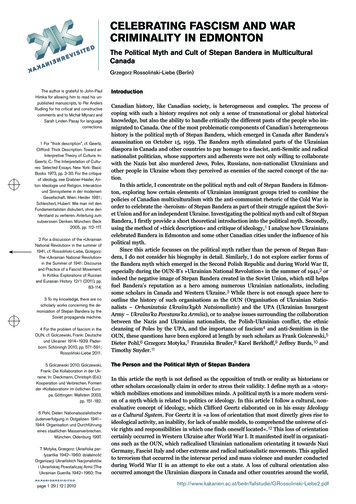
Transcription
CELEBRATING FASCISM AND WARCRIMINALITY IN EDMONTONThe Political Myth and Cult of Stepan Bandera in MulticulturalCanadaGrzegorz Rossoliński-Liebe (Berlin)The author is grateful to John-PaulHimka for allowing him to read his unpublished manuscripts, to Per AndersRudling for his critical and constructivecomments and to Michał Młynarz andSarah Linden Pasay for languagecorrections.1 For "thick description", cf. Geertz,Clifford: Thick Description: Toward anInterpretive Theory of Culture. In:Geertz, C.: The Interpretation of Cultures: Selected Essays. New York: BasicBooks 1973, pp. 3-30. For the critiqueof ideology, see Grabner-Haider, Anton: Ideologie und Religion. Interaktionund Sinnsysteme in der modernenGesellschaft. Wien: Herder 1981;Schleichert, Hubert: Wie man mit denFundamentalisten diskutiert, ohne denVerstand zu verlieren. Anleitung zumsubversiven Denken. München: Beck2005, pp. 112-117.2 For a discussion of the »UkrainianNational Revolution« in the summer of1941, cf. Rossoliński-Liebe, Grzegorz:The »Ukrainian National Revolution«in the Summer of 1941: Discourseand Practice of a Fascist Movement.In Kritika: Explorations of Russianand Eurasian History 12/1 (2011), pp.83-114.3 To my knowledge, there are noscholarly works concerning the demonization of Stepan Bandera by theSoviet propaganda machine.4 For the problem of fascism in theOUN, cf. Golczewski, Frank: Deutscheund Ukrainer 1914–1939. Paderborn: Schöningh 2010, pp. 571-591;Rossoliński-Liebe 2011.5 Golczewski 2010; Golczewski,Frank: Die Kollaboration in der Ukraine. In: Dieckmann, Christoph (Ed.):Kooperation und Verbrechen. Formender »Kollaboration« im östlichen Europa. Göttingen: Wallstein 2003,pp. 151-182.6 Pohl, Dieter: NationalsozialistischeJudenverfolgung in Ostgalizien 1941–1944: Organisation und Durchführungeines staatlichen Massenverbrechen.München: Oldenburg 1997.7 Motyka, Grzegorz: Ukraińska partyzantka 1942–1960: działalnośćOrganizacji Ukraińskich Nacjonalistówi Ukraińskiej Powstańczej Armii [TheUkrainian Guerilla 1942–1960: Thepage 1 29 12 2010IntroductionCanadian history, like Canadian society, is heterogeneous and complex. The process ofcoping with such a history requires not only a sense of transnational or global historicalknowledge, but also the ability to handle critically the different pasts of the people who immigrated to Canada. One of the most problematic components of Canadian’s heterogeneoushistory is the political myth of Stepan Bandera, which emerged in Canada after Bandera’sassassination on October 15, 1959. The Bandera myth stimulated parts of the Ukrainiandiaspora in Canada and other countries to pay homage to a fascist, anti-Semitic and radicalnationalist politician, whose supporters and adherents were not only willing to collaboratewith the Nazis but also murdered Jews, Poles, Russians, non-nationalist Ukrainians andother people in Ukraine whom they perceived as enemies of the sacred concept of the nation.In this article, I concentrate on the political myth and cult of Stepan Bandera in Edmonton, exploring how certain elements of Ukrainian immigrant groups tried to combine thepolicies of Canadian multiculturalism with the anti-communist rhetoric of the Cold War inorder to celebrate the ›heroism‹ of Stepan Bandera as part of their struggle against the Soviet Union and for an independent Ukraine. Investigating the political myth and cult of StepanBandera, I firstly provide a short theoretical introduction into the political myth. Secondly,using the method of »thick description« and critique of ideology,1 I analyse how Ukrainianscelebrated Bandera in Edmonton and some other Canadian cities under the influence of hispolitical myth.Since this article focusses on the political myth rather than the person of Stepan Bandera, I do not consider his biography in detail. Similarly, I do not explore earlier forms ofthe Bandera myth which emerged in the Second Polish Republic and during World War II,especially during the OUN-B’s »Ukrainian National Revolution« in the summer of 1941,2 orindeed the negative image of Stepan Bandera created in the Soviet Union, which still helpsfuel Bandera’s reputation as a hero among numerous Ukrainian nationalists, includingsome scholars in Canada and Western Ukraine.3 While there is not enough space here tooutline the history of such organisations as the OUN (Organisation of Ukrainian Nationalists – Orhanizatsia Ukraїns’kykh Natsionalistiv) and the UPA (Ukrainian InsurgentArmy – Ukraїns’ka Povstans’ka Armiia), or to analyse issues surrounding the collaborationbetween the Nazis and Ukrainian nationalists, the Polish-Ukrainian conflict, the ethniccleansing of Poles by the UPA, and the importance of fascism4 and anti-Semitism in theOUN, these questions have been explored at length by such scholars as Frank Golczewski,5Dieter Pohl,6 Grzegorz Motyka,7 Franziska Bruder,8 Karel Berkhoff,9 Jeffrey Burds,10 andTimothy Snyder.11The Person and the Political Myth of Stepan BanderaIn this article the myth is not defined as the opposition of truth or reality as historians orother scholars occasionally claim in order to stress their validity. I define myth as a ›story‹which mobilizes emotions and immobilizes minds. A political myth is a more modern version of a myth which is related to politics or ideology. In this article I follow a cultural, nonevaluative concept of ideology, which Clifford Geertz elaborated on in his essay Ideologyas a Cultural System. For Geertz it is »a loss of orientation that most directly gives rise toideological activity, an inability, for lack of usable models, to comprehend the universe of civic rights and responsibilities in which one finds oneself located«.12 This loss of orientationcertainly occurred in Western Ukraine after World War I. It manifested itself in organisations such as the OUN, which radicalised Ukrainian nationalism orientating it towards NaziGermany, Fascist Italy and other extreme and radical nationalistic movements. This appliedto terrorism that occurred in the interwar period and mass violence and murder conductedduring World War II in an attempt to eke out a state. A loss of cultural orientation alsooccurred amongst the Ukrainian diaspora in Canada and other countries around the Rossolinski-Liebe2.pdf
CELEBRATING FASCISM AND WAR CRIMINALITY INEDMONTONGrzegorz Rossoliński-Liebe (Berlin)Activity of the OUN and the UPA]Warszawa: Inst. Studiów Historycznych PAN 2006.8 Bruder, Franziska: »Den Ukrainischen Staat erkämpfen oder sterben!«Die Organisation Ukrainischer Nationalisten (OUN) 1929–1948. Berlin:Metropol 2007.9 Berkhoff, Karel C.: Harvest of Despair. Life and Death in Ukraine underthe Nazi Rule. Cambridge: Belknap2004.10 Burds, Jeffrey: AGENTURA:Soviet Informants’ Networks & theUkrainian Underground in Galicia,1944–48. In: East European Politicsand Societies 11/1 (1997),pp. 89-130.11 Snyder, Timothy: The Reconstruction of Nations: Poland, Ukraine,Lithuania, Belarus, 1569–1999.New Haven: Yale UP 2003; Snyder,Timothy: To Resolve the UkranianQuestion Once and for All: The EthnicCleansing of Ukrainians in Poland,1943–1947. In: Journal of Cold WarStudies, 1/2 (Spring 1999), pp. 86120. However, cf. also Jeffrey Burds’review of Snyder’s article on http://www.fas.harvard.edu/ hpcws/comment13.htm (accessed: 14.12.2010).12 Geertz, Clifford: Ideology as a Cultural System. In: Geertz 1973,pp. 193-233, here p. 219.13 Flood, Christopher G.: PoliticalMyth. A Theoretical Introduction. NewYork, London: Gerland Pub. 1996,pp. 15-26.14 Hein, Heidi: Historische Kultforschung. Digitales Handbuch zurGeschichte und Kultur Russlandsund Osteuropa. In: hung.pdf, pp. 4-5 (accessed:30.10.2009).15 Masaryk was neither a fascist noran authoritarian dictator but his charisma was used to create a cult whichhelped to legitimise the existence ofCzechoslovakia. Cf. Orzoff, Andrea:The Husbandman: Tomáš Masaryk’sLeader Cult in Interwar Czechoslovakia. In: Austrian History Yearbook 39(2008), pp. 121-137.16 There are many publicationsconcerning Hitler’s charisma. Theproblematic of the Hitler myth is wellexplained in Kershaw, Ian: The »HitlerMyth«: Image and Reality in the ThirdReich. Oxford: Clarendon Pr. 1987. Cf.page 2 29 12 2010although it was different in form than the loss that occurred in 1930s and 1940s WesternUkraine. At this time these communities began to celebrate Stepan Bandera and war criminals such as Roman Shukhevych as heroes of the Ukrainian nation.The political myth of Stepan Bandera has not been solely based on the person of StepanBandera. Generally, political myths are embedded in an ideology that provides them withmeaning. In the case of the Bandera myth, this meaning is provided by the ideology of Ukrainian nationalism that, in its radical version, appeared after World War I in Western Ukraine.Furthermore, embodiments of political myths can be understood as the visual component ofan ideology, as a captivating story or an image that is also a part of the propaganda of thisideology, which consists of many interconnected political myths.13 Apart from ideology, apolitical myth is interrelated to cults, rituals and symbols.The cult of Stepan Bandera and rituals based around his person are on the practical sideof the political myth of Stepan Bandera.14 The cult and rituals are practiced by those whobelieve in the myth, acting as its producers, receivers, or both. In the case of the politicalmyth of Stepan Bandera, it is a political cult of personality. The interwar period witnessedthe rise of a range of cults of personality in Europe. While some of them were not fascistor authoritarian, including the cult of Tomáš Garrigue Masaryk in Czechoslovakia,15 all ofthem relied on charisma to legitimate power. The leaders’ charisma was seldom ›natural‹,but was often fabricated by extensive propaganda measures. These cults sprang up in different political, cultural and social circumstances, accomplishing different purposes in thesocieties where they were applied. It would thus be wrong to equate them, but it is possibleto compare them given that comparing does not only mean looking at similarities but alsodifferences. The most well-known European cults of personality were established aroundthe most anti-Semitic European leader, Adolf Hitler in Germany,16 the prototype of thefascist leader Benito Mussolini in Italy,17 Francisco Franco in Spain,18 Antonio Salazar andRolăo Preto in Portugal,19 Philippe Pétain in France,20 Ante Pavelić in Croatia,21 CorneliuZelea Codreanu and Ion Antonescu in Romania,22 Józef Piłsudski23 and Roman Dmowskiin Poland, Vidkun Quisling in Norway,24 Iosif Stalin in the Soviet Union,25 Miklós Horthyin Hungary,26 Engelbert Dollfuß and Kurt Schuschnigg in Austria,27 Andrej Hlinka and Jozef Tiso in Czechoslovakia and Slovakia,28 Antanas Smetona in Lithuania,29 Ahmed Zog inAlbania,30 Aleksandar I. Karadordević in Yugoslavia,31 Mustafa Kemal Atatürk in Turkey,32Anastasii Vonsiatskii and Konstantin Rodzaevskii among Russian émigrés,33 and severalothers.34However, the myth of Stepan Bandera cannot be reduced to the cult of personality. Themyth also relates to events that Bandera did not participate in, as well as persons who identified themselves and were recognized by others as the banderites (Ukrainian banderivtsi),referring thereby to the name of Stepan Bandera. The symbol of Bandera was also frequentlyused to denote an epoch in which, as the believers of the myth would purport, the ›Banderageneration‹ had struggled for Ukraine.The development of the political myth of Stepan Bandera began before Word War II inthe South-Eastern territories of the Polish Republic, inhabited primarily by Ukrainians. Inthe beginning, the myth was shaped by the Polish-Ukrainian conflict and Warsaw’s nationalistic politics against the Ukrainian minority. In particular, the Bandera myth evolvedfollowing the assassination of the Polish interior minister, Bronisław Pieracki, by the OUNactivist Hryhorii Matseiko in June 1934, and the subsequent trials of OUN members in 1935and 1936 in Warsaw and L’viv. Advocates of Ukrainian nationalism perceived these trialsas part of their ongoing struggle for the liberation of Ukraine, linking them explicitly withBandera’s name and helping to symbolise him as the ›brave Ukrainian heart‹.During World War II the myth evolved and spread amongst members of different nationalities and religious groups that inhabited or occupied the territories of Western Ukraine,including groups of Galician Ukrainians, Jews, Poles, Germans and Soviet Russians and Ukrainians. One of the most important events that propelled the rise of the political myth andcult of Stepan Bandera during World War II was the »Ukrainian National Revolution« ofthe summer of 1941, which began at the outset of the German-Soviet war on June 22, 1941.It was then that the OUN-B proclaimed a Ukrainian state in L’viv on June 30, 1941, tryingto convince Nazi politicians to recognise it in hopes of becoming part of the New FascistEurope under the aegis of Nazi Germany. Stepan Bandera, as the providnyk (leader) of theOUN-B, was supposed to be the providnyk of the new Ukrainian fascist state. According olinski-Liebe2.pdf
CELEBRATING FASCISM AND WAR CRIMINALITY INEDMONTONGrzegorz Rossoliński-Liebe (Berlin)also Lepsius, M. Rainer: The Model ofCharismatic Leadership and Its Applicability to the Rule of Adolf Hitler. InPinto, António Costa/Eatwell, Roger/Larsen, Stein Ugelvik (Eds.): Charismaand Fascism in Interwar Europe. London: Routledge 2007,pp. 37-52.17 Gentile, Emillio: Mussolini as thePrototypical Charismatic Dictator. In:Pinto/Eatwell/Larsen 2007,pp. 113-127.18 Payne, Stanley G.: Franco, theSpanish Falange and the Institutionalisation of Mission. In: Pinto/Eatwell/Larsen 2007, pp. 53-62.19 Pinto, António Costa: ›Chaos‹ and›Order‹: Preto, Salazar and CharismaticAppeal. In: Pinto/Eatwell/Larsen2007, pp. 65-75.20 Baruch, Marc Olivier: Charismaand Hybrid Legitimacy in Pétain’s Étatfrançais (1940–1944). In: Pinto/Eatwell/Larsen 2007, pp. 77-85.21 Goldstein, Ivo: Ante Pavelić: Charisma and National Mission in WartimeCroatia. In: Pinto/Eatwell/Larsen2007, pp. 87-95; Cox, John K.: AntePavelić and the Ustaša State in Croatia. In: Fischer, Bernd J. (Ed.): BalkanStrongmen. Dictators and Authoritarian Rulers of South Eastern Europe.West Lafayette: Purdue UP 2007,pp. 199-238.22 Fisher-Galati, Stephen: Codreanu,Romanian National Traditions andCharisma. In: Pinto/Eatwell/Larsen2007, pp. 107-112.23 Hein, Heidi: Der Piłsudski-Kult undseine Bedeutung für den polnischenStaat 1926–1939. Marburg: HerderInst. 2002.24 Larsen, Stein Ugelvik: Charismafrom below? The Quisling Case inNorway. In: Pinto/Eatwell/Larsen2007, pp. 97-106.25 Apor, Balázs/Behrends, JanC./Jones, Polly/Rees, E.A. (Eds.): TheLeader Cult in Communist Dictatorships: Stalin and the Eastern Bloc. Basingstoke: Palgrave Macmillian 2004.26 Fenyo, Mario D.: Hitler, Horthy andHungary. New Haven: Yale UP 1972,p. 26f., p. 77f., pp. 140-143, p. 207f.27 Pauley, Bruce F.: Fascism and theFührerprinzip: The Austrian Example.In: Central European History 12/3(1979), pp. 281-286.page 3 29 12 2010the Führerprinzip, applied by the OUN-B, Bandera’s word would be above all written lawin the OUN-B state – he would become the embodiment of this fascist Ukrainian state. TheNazis, however, did not accept the state and took Bandera into captivity on July 5, 1941. Hewas transported to Berlin, where he stayed under house arrest until September 15, 1941. Hewas subsequently arrested and kept in a Berlin prison as an honorary prisoner (Ehrenhäftling) until October 1943. From October 1943 to October 1944 Bandera stayed in Zellenbau,a part of the concentration camp Sachsenhausen for political prisoners. After Bandera wasreleased he was once more allowed to collaborate.35What happened in Ukraine while Bandera was in Berlin was extremely significant for thepolitical myth of Stepan Bandera. During the »Ukrainian National Revolution« the OUN-Bestablished a militia that, together with German troops, organized and conducted pogroms.As a result of these activities between 13,000 and 35,000 Jews were killed by the perpetrators of the pogroms. The UPA, an army established by the OUN-B, conducted in 1943 inVolhynia and in 1944 in Eastern Galicia a campaign of ethnic cleansing against the Polishpopulation; as a result, between 70,000 and 100,000 people were killed. Simultaneously,the UPA partisans also killed several hundred Jews who had survived previous repressionsuntil then. Between 1944 and 1953, the UPA killed Ukrainians who were accused of collaborating with the Soviets. Altogether at this time the OUN-UPA killed more than 20,000 civilians. During their war against the OUN-UPA the Soviets killed 153,000, arrested 134,000and deported 203,000 members of the OUN-UPA, members of their families and randomWestern Ukrainian civilians. The fanatical and irresponsible fight of the OUN-UPA againstthe much more powerful Soviets certainly contributed to the massive and violent scale ofSoviet atrocities against Western Ukrainians. However, ultimately no one can be held moreresponsible for Soviet crimes than the Soviets themselves just as Poles were fully responsiblefor killing between 10,000 and 20,000 Ukrainians (both OUN-UPA members and civilians)during and after World War II.36The OUN-B activists and the UPA partisans who committed these atrocities were knownas banderites: Bandera’s people. This term was not invented by Soviet propaganda but datesback to the split of the OUN in late 1940 and early 1941, distinguishing members of the OUNB from members of the OUN-M faction, who became known as melnykites (mel’nikivtsi)after their leader Andrii Mel’nyk. Thus Bandera became the main symbol of the OUN-B andthe UPA although he himself did not participate in the atrocities of the OUN-B and the UPA.However, he is certainly responsible at least for the pogroms in June and July 1941 as heprepared the »Ukrainian National Revolution« and planned the OUN-B militia.Since 1944, Soviet propaganda helped to establish Stepan Bandera as the most tangiblesymbol of Ukrainian fascism and radical nationalism not only in Soviet Ukraine but also inmany other Soviet republics and satellite countries. By creating a narrative that portrayedBandera as an enemy of the ›decent‹ Soviet Ukrainians and condemning Ukrainian nationalism which celebrated Bandera’s ›anti-Sovietness‹, Soviet propaganda encouraged nationalist Ukrainian emigrants in Canada to glorify the person of Stepan Bandera, leading toa propagandistic campaign by the émigrés community against the Soviet Union throughoutthe Cold War. This effective engagement of the Ukrainian diaspora did not leave space fora critical sense of coming to terms with the Ukrainian nationalists’ collaboration with theNazis and their involvement in the Holocaust, the ethnic cleansing of Poles in Volhyniaand Eastern Galicia in 1943/44, and the massacres of civilian Ukrainians who supported orwere accused of supporting Soviet power in Western Ukraine between 1944 and 1951. TheUkrainian diaspora completely suppressed the memory of all the nationalistic, fascist andanti-Semitic features of Stepan Bandera, including such embarrassing rituals conducted bythe leaders of the »Ukrainian National Revolution« of 1941 as the greeting with the rightarm »slightly to the right, slightly above the peak of the head« while calling »Glory to theUkraine!« (Slava Ukraїni!) and responding »Glory to the Heroes!« (Heroiam Slava!).37Canadian Believers of the Bandera MythThe assassination of Bandera by the KGB agent Bohdan Stashynskyi allowed nationalist elements of the diaspora to blame the communist Soviet leaders, mainly Nikita Khrushchev, forhis death. Immediately after the assassination, the Bandera myth re-emerged amongst theUkrainian diaspora in Australia, Argentina, Canada, West Germany, Great Britain, the solinski-Liebe2.pdf
CELEBRATING FASCISM AND WAR CRIMINALITY INEDMONTONGrzegorz Rossoliński-Liebe (Berlin)28 Besier, Gerhard: ›BerufsständischeOrdnung‹ und autoritäre Diktaturen.Zur politischen Umsetzung einer ›klassenfreien‹ katholischen Gesellschaftsordnung in den 20er und 30er Jahrendes 20. Jahrhunderts. In: Besier, G./Lübbe, Hermann (Eds.): Politische Religion und Religionspolitik. ZwischenTotalitarismus und Bürgerfreiheit.Göttingen: Vandenhoeck & Ruprecht2005, pp. 79-110, here p. 107f.29 Kasparavičius, Algimantas: TheHistorical Experience of the TwentiethCentury: Authoritarianism and Totalitarianism in Lithuania. In: Borejsza, JerzyW./Ziemer, Klaus (Eds.): Totalitarianand Authoritarian Regimes in Europe: Legacies and Lessons from theTwentieth Century. New York, Oxford:Berghahn 2006, pp. 304-308.30 Fischer, Bernd J.: King Zog,Albania’s Interwar Dictator. In: Fischer2007, pp. 19-49.31 Farley, Brigit: King Aleksandar theRoyal Dictatorship in Yugoslavia. In:Fischer 2007, pp. 51-86.32 Ahmad, Feroz: Kemal Atatürk andthe Founding of the Modern Turkey. In:Fischer 2007, pp. 141-163.33 For Anastasiĭ Vonsiatskiĭ, cf.Stephan, John J.: The Russian Fascists. Tragedy and Farce in Exile1925–1945. New York: Hopper &Row 1978, pp. 91-140. For KonstantinRodzaevskiĭ, cf. Stephan 1978,pp. 73-90.34 In Canada fascist movementsoccurred as well, cf. Betcherman, LitaRose: The Svastika and the MapleLeaf. Fascist Movements in Canadain the 1930s. Toronto: Fitzhenry &Whiteside 1975.35 Motyka 2006, pp. 231-234; FSB(Federal’naia Sluzhba Bezopasnosti),Moscow, N-19092/T. 100, l. 233 (Stepan Bandera’s prison card).36 On the pogroms in western Ukraine, cf. Pohl, Dieter: Anti-JewishPogroms in Western Ukraine – AResearch Agenda. In: Barkan, Elazar/Cole, Elizabeth A./Struve, Kai (Eds.):Shared History – Divided Memory:Jews and Others in Soviet-OccupiedPoland, 1939–1941. Leipzig: Leipziger Univ.verl. 2007, pp. 305-313;Lesser, Gabriele: Pogromy w GalicjiWschodniej w 1941 r. [Pogroms inEastern Galicia in 1941]. In: Traba,Robert (Ed.): Tematy polsko-ukraińskie[Polish-Ukrainian Subjects]. Olsztyn:Wspólnota Kulturowas Borussiapage 4 29 12 2010and several other countries. Meanwhile, Soviet censorship and propaganda prevented thespread of the myth in Soviet Ukraine, promoting instead a radically different set of culturaland political activities, specifically the demonization of Stepan Bandera as well as all otherUkrainian fighters who at the same time had been glorified by the diaspora.The most significant places where the myth was reinvented and most rituals were performed were London, Munich, and Toronto. Influential newspapers were published in thesecentres. After Bandera’s assassination, the Munich-based The Way to Victory (ShliakhPeremohy), Ukrainian Thought (Ukraïns’ka Dumka) in London and the Toronto-based Ukrainian Echo (Homin Ukraïny) acted to revitalize, in a very intensive manner, the politicalmyth of Bandera, thereby influencing subscribers in other cities and countries. The Edmonton-based weekly Ukrainian News (Ukraïns’ki visti) was less prominent in the process ofmaking the political myth of Stepan Bandera.It is difficult to elucidate which individuals or what parts of the Ukrainian diasporawere influenced by the political myth of Stepan Bandera, or who celebrated the Banderacult in Edmonton. Ukrainians have been immigrating to Canada since the 1890s and as aresult the Ukrainian diaspora has been divided along generational lines, as well as levels ofpolitical exposure. The first stage in the development of the Bandera myth in the 1930s andthe 1940s influenced mostly Ukrainians in Poland. Concurrently, the Ukrainian diaspora inCanada was only marginally exposed to the Bandera myth. Due to the fact that this waveof the diaspora was less politicised or nationalist, it was not particularly enthusiastic aboutthis myth. The ideology of Ukrainian nationalism reached Canada and other places with alarge diasporic community only with the arrival of the DPs (displaced persons) after WorldWar II. Many of them refused to return to Soviet Ukraine as they feared being persecutedfor their collaboration with the Nazis.38Many DPs had grown up in interwar Poland and became acquainted with the Bandera myth during World War II. When these Ukrainians arrived in Canada even the morenationalist components of the Ukrainian diaspora did not adopt their very radical valuesand refused to work with them. The new political diaspora was on average more educatedand more politically active than the older generation that mainly consisted of farmers. Theyounger members of the diaspora organized youth groups, parishes, political parties, newspapers, Saturday schools, veteran associations, scholarly societies, credit unions, resorts,encyclopaedia projects, museums and archives, radio programs, sports, hobby clubs, etc.39The Cold War motivated Canadian politicians not to interfere with the anti-Soviet activitiesof these communities. The politics of multiculturalism, officially applied in the 1970s, a decade after the Bandera myth re-emerged, encouraged Canadian politicians to interpret theevents organized by radical nationalistic elements of the Ukrainian diaspora as an expression of Ukrainian culture.40The community of the banderites (mainly, but not exclusively consisting of former members of the OUN-B) had the strongest ideological roots. They acted radically and gained increasing numbers of members who became enthusiastic about the OUN-B’s plan to liberateUkraine from the Soviets and to clear its territory of ›enemies‹. The banderites establishedinfluential centers in Germany, the United Kingdom and Canada. In the United Kingdomthey took over the Association of Ukrainians in Great Britain.41 In Canada, on December25, 1949, they founded the LVU (League for the Liberation of Ukraine – Liga VyzvolenniaUkraїny). The League established some 20 community centres for its more than 50 branches in Canada. The most important medium that the banderites used to spread their ideasand to influence the mindset of Canadian Ukrainians was the newspaper Ukrainian Echo,published in Toronto. The official website of the League shows that the League has beenwilling to combine Ukrainian nationalism with the policy of multiculturalism in Canada:The League’s main focus, however, was on the promotion of national independencefor Ukraine and human rights for the Ukrainian people, while advancing the interests of the Ukrainian Canadian community within the framework of multiculturalism in Canada. Public actions included rallies, demonstrations, political massmeetings, seminars, conferences, public lectures, petitions and mass mailings.42The League also organized women’s, youth’s and veteran’s organizations like the SUM(Ukrainian Youth Association – Spilka Ukraїns’koї Molodi) or the OZhLVU (Women’sAssociation of the Canadian League for the Liberation of Ukraine – Obiednannia Rossolinski-Liebe2.pdf
CELEBRATING FASCISM AND WAR CRIMINALITY INEDMONTONGrzegorz Rossoliński-Liebe (Berlin)2001, pp. 103-126. Similar waves ofpogroms also broke out shortly afterthe start of the German-Soviet war inNorth-Eastern Poland, Lithuania, Latvia, Estonia, Bessarabia and Bukovina.For pogroms in Poland, cf. Żbikowski,Andrzej: Pogroms in NortheasternPoland – Spontaneous Reactionsand German Instigations. In: Barkan/Cole/Struve 2007, pp. 315-354. Forpogroms in Lithuania, cf. Dieckmann,Christoph: Lithuania in Summer 1941.The German Invasion and the KaunasPogrom. In: Barkan/Cole/Struve 2007,pp. 355-385. For Latvia and Estonia,cf. Bundesarchiv Berlin LichterfeldeR58/215, l. 134. (EreignismeldungUdSSR, Nr. 40, 01.08.1941). ForBessarabia and Bukovina, cf. Solonari, Vladimir: Patterns of Violence.The Local Population and the MassMurder of Jews in Bessarabia andNorthern Bukovina, July-August 1941.In: Kritika: Explorations in Russian andEurasian History 8/4 (2007), pp. 749787. The first pogrom actions in L’vivstarted probably on 30 June 1941 oreven before. For testimonies that datethe beginning of the violent actionsto July 1, 1941, cf. Lewin, Kurt I.:Przeżyłem. Saga Świętego Jura spisana w roku 1946 [I Survived. The Sagaof Saint George Written in the Year1946]. Warszawa: Zeszyty Literackie2006, pp. 56-57; AŻIH (ArchiwumŻydowskiego Instytutu Historycznegow Warszawie) 229/54, Teka Lwowska[L’viv portpholio], l. 2. For the course ofthe pogrom in L’viv, cf. Mick, Christoph:Ethnische Gewalt und Pogrome inLemberg 1914 und 1941. In: Osteuropa 53 (2003), pp. 1810-1829,here p. 1810f., pp. 1824-1829; Heer,Hannes: Einübung in den Holocaust:Lemberg Juni/Juli 1941. In: Zsf. f. Geschichtswissenschaft 49 (2001), pp.409-427, here p. 410, p. 424; Bruder2007, pp. 140-150; Grelka, Frank: Dieukrainische Nationalbewegung unterdeutscher Besatzungsherrschaft 1918und 1941/1942. Wiesbaden: Harrassowitz 2005, pp. 276-286; Pohl 1997,pp. 60-62; Wachs, Philipp-Christian:Der Fall Theodor Oberländer (1909–1998). Frankfurt/M: Campus 2000,p. 71, pp. 78-80. For the violent actions against Poles in Volhynia andGalicia, see Motyka 2006,pp. 298-400; Snyder 1999, pp. 93100. For the second Soviet occupationof Western Ukraine, the brutal conflictbetween the Soviets and the OUNUPA, and the terror conducted by theSoviets and the OUN-UPA againstthe civil population, cf. Burds 1997,pp. 104-115; Bruder 2007, p. 231f.,p. 261f.; Motyka 2006, pp. 503-574,p. 649f.; Boekh, Katrin: Stalinismusin der Ukraine. Die Rekonstruktionpage 5 29 12 2010Ligy Vyzvolennia Ukraїny). The deeper meaning and main purpose behind the organizational activities of the banderites was to prepare their children for an eventual battle for anindependent Ukrainian state. This battle would be the continuation of the fascist Ukrainianrevolution of the summer of 1941 and the struggles of the UPA between 1943 and 1953. Forthis purpose, in 1962 a monument to the h
myth of Stepan Bandera, it is a political cult of personality. The interwar period witnessed . not fascist or authoritarian, including the cult of Tomáš Garrigue Masaryk in Czechoslovakia,15 all of them relied on charisma to legitimate power. The leaders' charisma was seldom ›natural‹, but was often fabricated by extensive propaganda .
